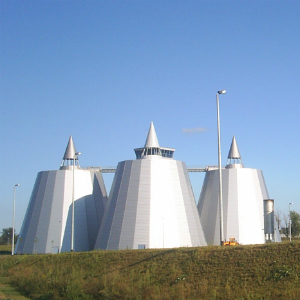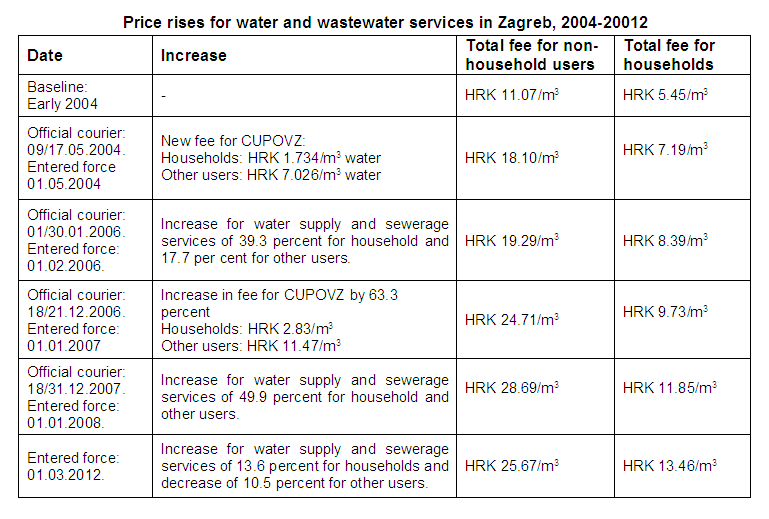Zagreb Wastewater Treatment Plant (CUPOVZ), Croatia
The EBRD-financed Zagreb Wastewater Treatment Plant, which opened in phases between 2004 and 2007, was intended to improve water quality in the River Sava. No-one disputed that some wastewater treatment was needed in the city, but the project which was developed has brought more questions than answers and cost Zagreb’s residents dearly.
The contract has locked the city of Zagreb into an oversized and overpriced project, and when industrial users refused to pay the increased fees, the city authorities started to use taxpayers’ money to pay them instead. In spite of this, however, in 2012 it emerged that the city owes the concession company EUR 180 million, raising questions about the future of the project.
Ownership and financing of the project
The plant is run by Zagrebačke Otpadne Vode (ZOV), which built and will operate the treatment plant for 28 years, before transferring its operation to another party, under a BOT arrangement – Build-Operate-Transfer.
ZOV is 97 percent owned by a consortium consisting of RWE Aqua GmbH, a subsidiary of German utility RWE AG, and WTE Wassertechnik, a subsidiary of the Austrian utility EVN AG. The remaining 3 percent is owned by Vodoprivreda Zagreb, a municipal company of the City of Zagreb, which is being partially privatised.
In 2001 the EBRD approved a EUR 55 million loan for the project, with a further EUR 115 million loan from German development bank Kreditanstalt für Wiederaufbau (KfW ).

Key issues:
poor risk allocation leading to high fees for residents and businesses
lack of transparency
constant rises in the cost of the project
oversized project
controversial charging system
long contract locking the city into unfavourable arrangement
What does it actually cost?
The total cost of the project has risen several times and is still shrouded in mystery. Some of the quoted prices include:
- EUR 176 million (Decision by City Assembly, 2001) (DM 352 000 200)
- EUR 292.7 million (EBRD, end 2003)
- EUR 220 million (Spring 2007)
- EUR 253 million (City Council, December 2007)
- EUR 326.7 million (EBRD, end 2007)
- EUR 265 million (City Council, May 2008)
- EUR 299 million (City Council, 2012)
The justifications given for the price rises include a package of seven measures, mainly involving an increase in capacity, costing EUR 19.2 million, fourteen other extensions to the project worth EUR 15.2 million and the need to cover the main drainage channel leading to the plant, costing EUR 16.3 million.
The covering for the malodorous channel, which runs through a low-income suburb of Zagreb, was mentioned in the EBRD’s 2001 press release, so it is unclear why the city council did not approve expenses for it until several years later. Totalling around EUR 50.7 million, these justifications fail to account for most of the price discrepancies.
An additional cost arises in the fact that the project does not include final treatment or disposal for the sewage sludge resulting from the treatment process. Although anaerobic digesters are part of the project, these have been built so as not to be sufficient to completely process all of the sludge.
This seems to have been done on purpose to try to justify the construction of a waste incinerator proposed by Novum, a sister company of WTE Wassertechnik, on the same site as CUPOVZ. The incinerator was not included in the Environmental Impact Assessment and its costs – estimated to range between EUR 170 and EUR 290 million – are not included in the CUPOVZ project.
Technically speaking, a “totally unsuitable” project
The cost increases are of even greater concern considering that the Expert Commission appointed by Zagreb City Council to examine the project described it as “totally unsuitable for the current state of the sewage system and drainage conditions of Zagreb” and indicated that it would not lead to the improvements expected.
The Commission stated that the drainage system in Zagreb first needed to first be renewed in order to separate streamwater from the neighbouring mountain from the city’s wastewater, in order to avoid having massive fluctuations in the quantity and level of dilution of the water. The Commission also expressed concern that the cost of CUPOVZ would place a heavy financial burden on residents.
The Commission instead proposed to:
- carry out a proper analysis of the River Sava’s water quality before proposing appropriate solutions, and gradually build facilities whilst carrying out further research and training
- separate the streams from the drainage system to improve the functioning of the water treatment equipment
- install a simple mechanical system (around ten times cheaper) whilst upgrading the city sewer system
- build a retention system to prevent storm water flowing straight into the Sava
The Commission was ignored by the City Council and disbanded.
The decision to include the Domovinski Bridge in the project was also controversial, as it added an estimated EUR 27.6 million to the cost of the project, which would be borne by citizens through their water bills, even though they already pay taxes meant for road infrastructure. The Expert Commission also stated that the bridge was unnecessary, since it was possible to have a smaller treatment plant on the south side of the river.
There is a huge variation between the costs published by the EBRD and those quoted by the city council, raising suspicions that the city council is still not revealing the full costs. The contract has never been released.
Who wins, who loses?
In 2004 the City started to pay ZOV monthly fees for the wastewater treatment plant, which have to be paid irrespective of how much money has been collected from residents and businesses. The public sector bears the demand risk, while the company bears the much milder availability risk – it is much easier to control the functioning of the plant than it is to control the public and businesses paying their bills.
The monthly fees totalled EUR 28.1 million for 2004 alone, although only the mechanical part of the plant was in operation, and only from April of that year onwards.
According to the state auditor, between April 2004 and the end of 2006 the City of Zagreb had already paid ZOV 75.5 percent of the basic fixed costs of the plant’s construction, raising the question of why the city could not have raised the funds to carry out the project through normal public procurement.
The City of Zagreb was due to pay ZOV a total of EUR 44.79 million in 2007, rising to EUR 48.12 million in 2010, with a total fee in 2007-2010 of EUR 294.15 million – much more than the price of the original investment.
Since mid-2004 when the mechanical part of the plant began to operate, there have been several price rises for water and wastewater services, for both businesses and residents.
The public sector bears the demand risk, while the company bears the much milder availability risk – it is much easier to control the functioning of the plant than it is to control the public and businesses paying their bills.
Since mid-2004 when the mechanical part of the plant began to operate, there have been several price rises for water and wastewater services, for both businesses and residents.

For non-household users, the fees are now 2.31 times more expensive than before CUPOVZ began to operate, and for households they are 2.47 times higher, related to the level of early 2004.
While price rises can be justified to some extent to cover worthwhile investments and improvements in service, the questionable size and functionality of the project coupled with rapid price rises resulted in protests from businesses and trade unions in 2007 after price rises – estimated to add EUR 6.2 – 7.6 to the average household water bill each month – coincided with increases in waste collection and public transport fees in Zagreb, and rising food and oil prices worldwide.
In April 2008 a committee appointed by the Government to examine price increases in Croatia reached an agreement with Zagreb City Council and made a token reduction in total water price for households to HRK 11.22 per cubic metre.
Several companies refused to pay their increased bills. By 27.08.2004, only HRK 20 million of out a total HRK 53 million owed by industry had been paid.
One of the most vocal critics of the price rises was petrochemical and plastics manufacturer Dioki, which claimed that it was charged for the amount of water which entered the plant, not the amount that came out and required treatment. In other words, it paid for the treatment of 150 million cubic metres of water per year when it claimed that only 100 million cubic metres entered the drainage system.
By the end of 2007 the City of Zagreb had launched two seizure orders for more than HRK 30 million against Dioki. Dioki responded by publishing a paid advertisement in several daily newspapers in December 2007 entitled “We want a clean bill for the treatment plant,” listing its reasons for dissatisfaction. Other companies using water for cooling or manufacturing beverages are similarly dissatisfied.
City Countil covers part of the debt
In 2006 the City Council started to cover some of the company’s debts using the city budget, ie. taxpayers’ money, after ZOV threatened that it would not be able to continue with the works it was carrying out. The City has been unable to raise around 30 per cent of the total fees from bills.
In late 2007 opposition parties in Zagreb City Council – HDZ and HSLS tabled an amendment to reduce the amount paid to ZOV, however it was rejected, as Council members were unwilling to break Zagreb’s contractual obligations. Around the same time, Deputy Mayor of Zagreb Ivo Jelusic told the Poslovni Dnevnik business daily that the City Council would try to change the contract with ZOV, however this has not happened.
In April 2012, the City of Zagreb owed EUR 180 million to ZOV, so speculation arose that RWE might abandon the project because of poor cooperation with Zagrebacki Holding d.o.o. and the negative public perception of the project. However, RWE decided to stay in the project for now.
It was announced that so far, the City of Zagreb had paid EUR 426 million to ZOV, and it was estimated that this could total EUR 1.48 billion by 2028.
While the City Council could be penalized for its incompentence in the next local elections in May 2013, unless some serious action is taken, ZOV will be in power until 2028.
